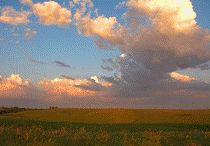North American Prairie Conference
Date of this Version
1989
Abstract
Rhizome and tiller development of ungrazed switchgrass (Panicum virgatum L.), prairie sandreed [Calamolvilfa longifolia (Hook) Scribn.], and sand bluestem [Andropogon gerardii var. paucipilus (Nash) Fern.] were studied for two years in the Nebraska Sandhills. Rhizome growth of switchgrass began at the 4- to 5-leaf stage. Following tiller elongation, no new rhizomes developed but rhizome elongation continued. Many of the prairie sandreed tillers were biennial similar to those of indiangrass [Sorghastrum nutans (L.) Nash]. Spring tiller development on prairie sandreed came from both vertical and horizontal rhizomes and continuing growth of late emerging tillers from the previous year. New rhizomes began growth at the 4- to 5-leaf stage. Prairie sandreed was the only grass to have rhizomes deeper than 10 cm. In sand bluestem, buds on rhizomes that were underneath the previous year's tiller lived over winter. In the spring after a tiller emerged through the soil and reached the 4- to 5-leaf stage meristematic tissue below the shoot apex elongated forming a rhizome which pushed the shoot apex to the soil surface. The newly formed rhizome initiated buds which served as the site of the following year's tiller development. Normal tiller elongation and inflorescence formation occurred later in the season. Prairie sandreed and sand bluestem are adapted to sand burial while switchgrass requires a more stable soil.


Comments
Published in Prairie Pioneers: Ecology, History and Culture: Proceedings of the Eleventh North American Prairie Conference, August 7-11, 1988, Lincoln, Nebraska (Lincoln, NE 1989).